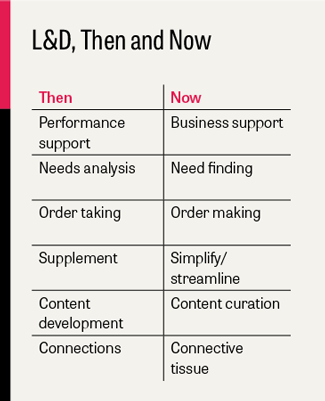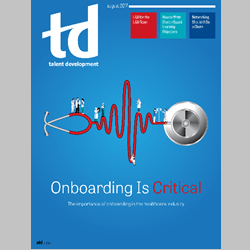TD Magazine Article
L&D for L&D
As much as the learning and development function has changed over time, so too have the skills needed to work in the field.
Tue Aug 01 2017


As much as the learning and development function has changed over time, so too have the skills needed to work in the field.
The past several decades have seen a significant transformation in the learning and development profession. From its humble beginnings as the metaphorical schoolhouse, this field has evolved into a powerhouse, delivering business results and earning its rightful seat at the table.
More and more organizations are looking to the learning function to actively partner with and guide people toward greater effectiveness in an increasingly complex and uncertain future. And preparing for that future demands an understanding of where L&D has been, where it's going, and what skills L&D professionals will need to get there.
We've come a long way
Although L&D practitioners tend to keep their eyes focused on the future, it's helpful to briefly reflect on how the role has changed over just the past handful of years.
In the early days of "employee education," the L&D function offered training support, creating and delivering primarily instructor-led learning experiences. Trainers took on the teacher role and imparted and tested new knowledge. This activity-based focus quickly gave way to playing a performance support role—helping employees translate new knowledge and skills into behavior change on the job.
But today's internal clients expect more than that; they expect business support. Executives aren't interested in behaviors, competencies, and all the bells and whistles that fascinate L&D professionals. Instead, they expect a savvy business partner who will offer learning solutions designed to help them deliver outcomes and drive key business indicators.
Again, in the early days, L&D staff looked around, used their good judgment and common sense, and determined what training the organization and its people needed. That insular, top-down approach morphed into a more systematic needs assessment and analysis process that involved asking before telling. Expansive evaluations, surveys, and focus groups can yield extensive data to be combed through and considered as the basis for training solutions. But as expectations rise, complexity increases, and business keeps speeding up, this long lead-time approach frequently falls out of pace with the needs of many organizations.
Today, L&D staff must shed reactive, lengthy practices and become far more proactive and nimble. In the contemporary environment, once a training need has emerged, the organization and its employees are already falling behind. If employees can't effectively perform a part of their jobs, the product or customer already is suffering. As a result, the L&D professionals who are most effective tend to engage in "need finding," which means they keep an eternal ear to the ground, sensing where patterns and trends might lead. They develop the capacity to anticipate the "seeds of needs" that might be getting ready to sprout and take preemptive steps to support emerging learning needs—and the business.
For L&D practitioners, that means shifting from being order takers, serving up what internal customers might ask for, to being real partners who are deeply knowledgeable about the business. It means taking a leadership role in sensing what's really happening and seeking out the perspectives of those involved. But it also involves pushing back against ideas and proposals from internal customers (even executives) that aren't in the organization's or the employees' best interests. It involves pointing out when the wrong problem is being solved, when training isn't the appropriate solution, or when training is being misused to check a box or offload responsibility. And it involves proactively offering up solutions and learning programs to address skills and performance gaps that might not yet even be articulated.
But the evolution of the role isn't reserved exclusively to the realm of shifts in the what and when of the job. L&D professionals also must evolve their thinking about how they approach this mission-critical role.
Leap of faith
In the past, success was defined by contributions to the pool of knowledge—and bookshelves of binders. But in our information-overloaded environment, today a greater contribution frequently involves stripping away the unnecessary, simplifying what already exists, and streamlining the tools and instruction provided to employees. Less really is more when it comes to learning, but this evolution in philosophy can require a significant leap of faith for those who once judged their own worth based upon hours of seat time, number of slides, and the volume of a participant's manual.
In many instances, that means a change in focus from content development to content curation. The instructional reality we face today is that so much material already exists. Is it necessary to generate new feedback models or presentation strategies? Often, what we need is readily available; there's no need to reinvent the wheel. For some in the field, that can feel like a loss—a loss of cache, creativity, and contribution.
But, in reality, content curation demands a new level of resourcefulness and ingenuity as the L&D function weaves together new concepts, sources, and media. Content curation (as opposed to creation) adds tremendous value by enabling frequently under-resourced teams to do more with less, which is essential in today's atmosphere of shortened deadlines and shrinking budgets.
Let's face it: More than ever, the L&D function is challenged with leaner and leaner resources—a dynamic that likely will not reverse itself anytime soon. In response, smart L&D staff are borrowing a tool used by skillful facilitators: networking.
The best trainers know that the one-on-one connection they create with participants in a classroom is not nearly as powerful or sustainable as the connections and conversations they facilitate among participants. So, they network the group, directing one participant's question to another participant, requiring the group to work together to resolve issues, which encourages ongoing relationships and support.
Although it's tempting for the training department to strive to be the source of all learning, today it's essential to instead help internal clients network—to make their own connections, speak with internal experts, create support groups, engage in mutual mentoring, and drive their own learning. Greater self-sufficiency is the model of the future.
Continuous learning begins with L&D
This evolution of L&D is necessary, exciting, and a bit daunting. It requires that L&D practitioners turn a careful eye on their own development. Like the shoemaker's children, though, L&D staff frequently invest considerably more time and attention to the growth of others rather than themselves.
While selfless, that is entirely unsustainable. It's time for L&D professionals everywhere to ask and address these questions:
What do I need to continue to grow and contribute effectively?
What do I need to keep up with my evolving role?
What do I need to set myself and my clients up for success?
When asked about the development they need, L&D practitioners typically will dive directly into the deep end of the technical pool—talking about the latest authoring tools, learning management system features, brain research, and instructional strategies. Those technical topics are certainly important, but they don't tend to answer the questions or help people make significant leaps in terms of their capacity or contribution to the organization.
It tends to be the softer (rather than the harder) skills that propel those in L&D (and those whom they serve) forward. So, perhaps it's time to focus on the following ABCs (and DEFs) that represent high-impact nontechnical competencies instead.
Agility. Success depends on being able to continually nurture a willingness to make novel connections, try new approaches, and reconsider how things are done. It means holding lightly to today's best practices, knowing that more effective strategies might present themselves at any time. It also means developing the interpersonal flexibility required to meet an increasingly diverse set of internal customers and learners where they are as the first step to guiding them where they need to be.
Business acumen. Throwing out a few key terms used to be enough to get by. But today, being a credible business partner means knowing the customer and its strategy like never before. L&D professionals must understand the business from top to bottom—from research and development to production, to sales and service. And they must become deeply aware of and fluent in a complex range of issues facing the organization.
Content scanning, skimming, and soaking. The volume of important information that is available is unconquerable—and tomorrow there will be even more. The only hope for L&D staff is to become skillful skimmers and speed readers.
That involves developing a discipline around keeping a keen eye out for books, authors, articles, videos, and other possible sources of valuable knowledge. But rather than intending to devour it all (which frequently results in a never-diminishing stack of paper that generates more guilt than insights), quickly review the beginning, ending, table of contents, and significant subheadings. Set aside items that demand deeper attention now and simply make a note of the big idea or essence of what was scanned. That allows you to remain current and be able to locate and dig into what you need when you need it.
Design thinking. Design thinking is an ideal method for approaching learning challenges. It ensures that L&D practitioners focus on asking the right questions from the start; deepen—and make visceral—their understanding of the user experience; and respond to "turn-on-a-dime" requests by advancing projects through quick pilots and rapid prototyping.
Evaluation and measurement. This perennial competency only becomes more important as the L&D function partners to deliver, measure, and validate its contributions to business outcomes.
Frugally focused creativity and innovation. Creativity and innovation always have been critical to crafting learning solutions that engage and move the needle when it comes to behavior change. However, frugality is becoming an increasingly important differentiator. Few L&D departments boast of budget increases; in fact, the news is generally about shrinking budgets—without commensurate decreases in the expectations of what those budgets can deliver. As a result, finding effective and cost-effective ways to drive learning and change is among today's greatest challenges.
As the role of the L&D function evolves, so must the skills and approaches used by its practitioners. And the outlook is bright—because let's face it, who's better suited for ongoing growth and learning than this group?

